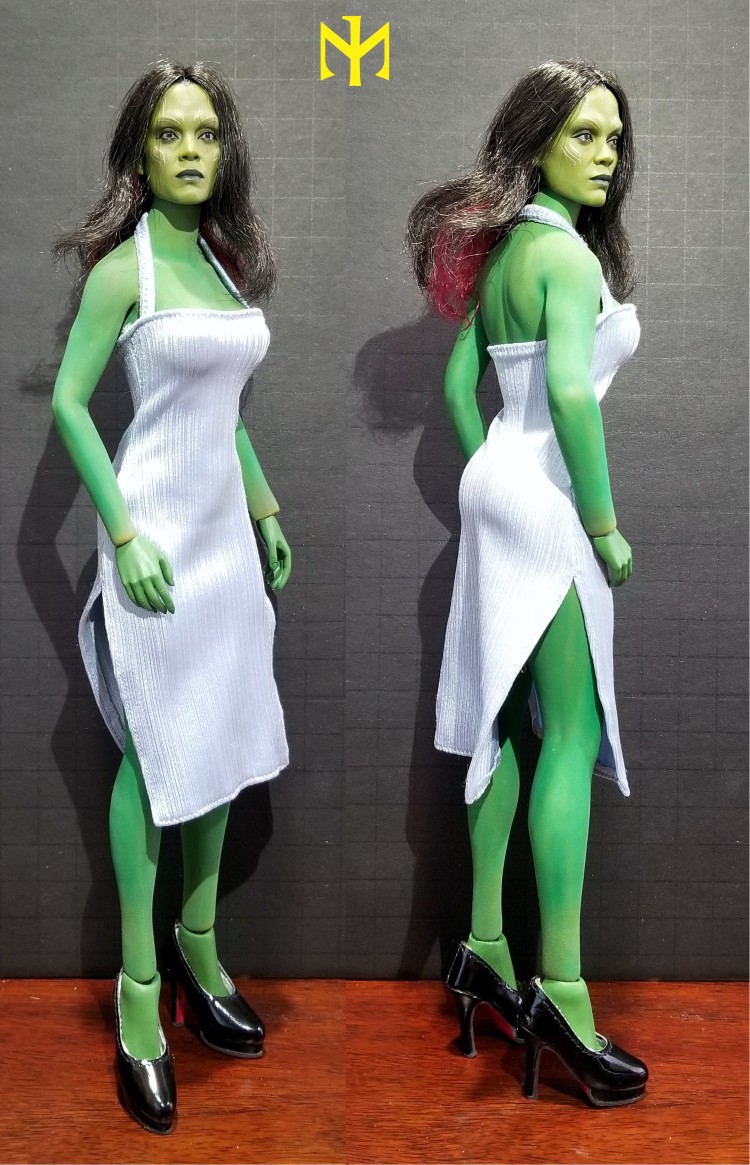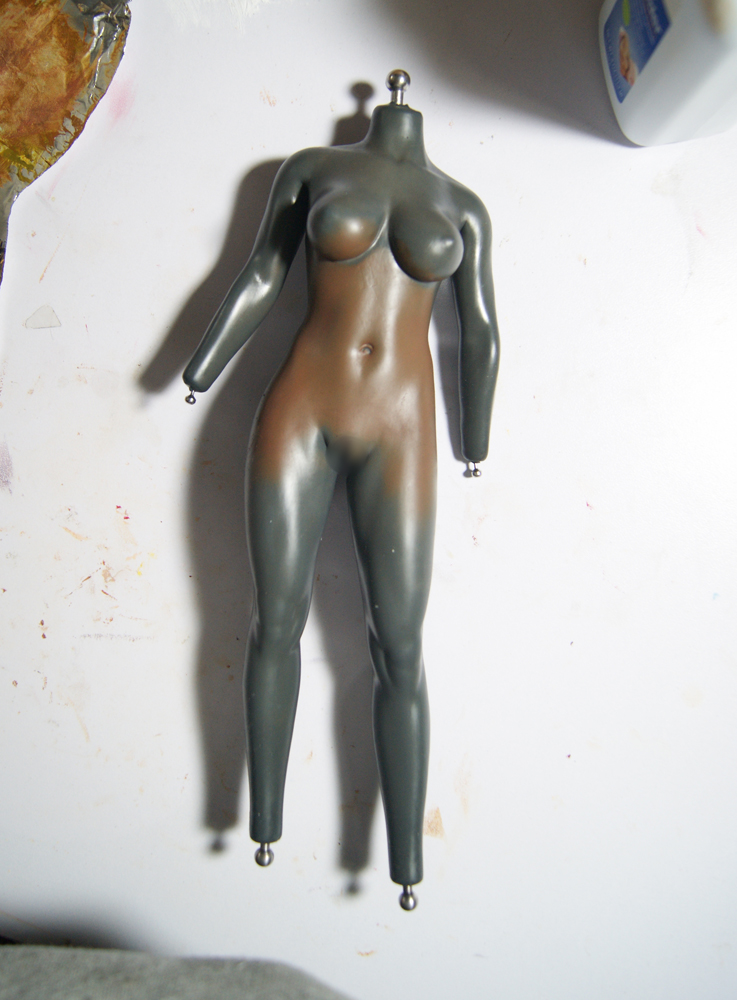Update on painting silicone seamless bodies (Phicen/TBLeague) with Paint Markers
We already have viable options for painting a silicone body (or sizable parts of it) -- my preference being to use oil pastel. But when it comes to smaller and finer designs on the body, that seems almost impossible to use -- you are unlikely to get the pastel sharp enough, and if you do it will break off immediately, and even if you got past that hurdle, you would end up smudging your design when you try to rub it into the surface. That is why, for painting hair and tattoos, I turned to alternatives. The Uni Pin Fine Line fineliner drawing pen works very well but only when applied directly to the silicone surface (one that is not colored with oil pastel already) -- see Post 192 above. Oil-based ink Pilot drawing pens worked quite well onto the oil-pastel-colored silicone surface, but required multiple and vigorous massages with clean dry paper towels to get the ink to stop transferring -- see Post 205 above. So I was still looking for a better option, as I embarked upon a second custom seamless Darth Maul project.
I experimented with a variety of Paint Markers, both oil-based and acrylic, but they had a tendency to smudge or rub off or crack and flake off -- see Post 1 above for acrylic. I finally turned to industrial markers, harder to find and often more costly. Repeated testing demonstrated that the Markal Pro-Line XT paint marker (now Xylene free) was the best solution. It does have some drawbacks -- Xylene free or not, you should use it in a well-ventilated area; it dries fairly shiny -- although that is largely offset by the eventual application of protective powder; when you stretch a painted area, the paint from the marker can crack like acrylic does, but generally not as much and it does not flake off or rub off (it did in just a couple of perhaps lightly painted spots, for example where the top of the harder plastic foot kept rubbing onto the bottom of the silicone lower leg -- it is very easy to fix with another spot application); worst of all, the marker's tip is quite wide (and there are no other sizes available in that line), so I had to flood tiny pools of marker paint and dip a toothpick into them to painstakingly paint smaller details. You can see the result below.

Some words of caution: beyond using this in a well-ventillated space, I would say reserve it for smaller areas and details, not for a whole base color (because of the potential for cracking); also, when applying it to the silicone body, make sure the areas you are covering are in a non-stretched position at the time of application -- stupidly thinking that it would preempt cracking, I tried applying the marker to a stretched area of a test subject body, and it caused a bunch of little holes to appear (presumably melting the thinnest silicone areas and releasing air bubbles?) on the surface.
For Maul 2.0 (pictured above with the marker), I used oil pastels for the base color of the body (there is such a thing as going too far/rough with the make-up sponge, so don't get carried away), Markal Pro-Line XT paint marker (or its ink) for the body markings, underlayers of red and black Markal Pro-Line XT paint marker and overlayers of Vallejo acrylics mixed with Liquitex ultra matte medium (thanks for the suggestion) for the harder plastic hands and feet. More photos HERE (Post 39).
I hope this is useful.
We already have viable options for painting a silicone body (or sizable parts of it) -- my preference being to use oil pastel. But when it comes to smaller and finer designs on the body, that seems almost impossible to use -- you are unlikely to get the pastel sharp enough, and if you do it will break off immediately, and even if you got past that hurdle, you would end up smudging your design when you try to rub it into the surface. That is why, for painting hair and tattoos, I turned to alternatives. The Uni Pin Fine Line fineliner drawing pen works very well but only when applied directly to the silicone surface (one that is not colored with oil pastel already) -- see Post 192 above. Oil-based ink Pilot drawing pens worked quite well onto the oil-pastel-colored silicone surface, but required multiple and vigorous massages with clean dry paper towels to get the ink to stop transferring -- see Post 205 above. So I was still looking for a better option, as I embarked upon a second custom seamless Darth Maul project.
I experimented with a variety of Paint Markers, both oil-based and acrylic, but they had a tendency to smudge or rub off or crack and flake off -- see Post 1 above for acrylic. I finally turned to industrial markers, harder to find and often more costly. Repeated testing demonstrated that the Markal Pro-Line XT paint marker (now Xylene free) was the best solution. It does have some drawbacks -- Xylene free or not, you should use it in a well-ventilated area; it dries fairly shiny -- although that is largely offset by the eventual application of protective powder; when you stretch a painted area, the paint from the marker can crack like acrylic does, but generally not as much and it does not flake off or rub off (it did in just a couple of perhaps lightly painted spots, for example where the top of the harder plastic foot kept rubbing onto the bottom of the silicone lower leg -- it is very easy to fix with another spot application); worst of all, the marker's tip is quite wide (and there are no other sizes available in that line), so I had to flood tiny pools of marker paint and dip a toothpick into them to painstakingly paint smaller details. You can see the result below.

Some words of caution: beyond using this in a well-ventillated space, I would say reserve it for smaller areas and details, not for a whole base color (because of the potential for cracking); also, when applying it to the silicone body, make sure the areas you are covering are in a non-stretched position at the time of application -- stupidly thinking that it would preempt cracking, I tried applying the marker to a stretched area of a test subject body, and it caused a bunch of little holes to appear (presumably melting the thinnest silicone areas and releasing air bubbles?) on the surface.
For Maul 2.0 (pictured above with the marker), I used oil pastels for the base color of the body (there is such a thing as going too far/rough with the make-up sponge, so don't get carried away), Markal Pro-Line XT paint marker (or its ink) for the body markings, underlayers of red and black Markal Pro-Line XT paint marker and overlayers of Vallejo acrylics mixed with Liquitex ultra matte medium (thanks for the suggestion) for the harder plastic hands and feet. More photos HERE (Post 39).
I hope this is useful.








